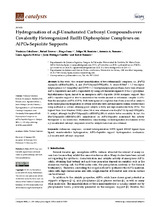Hydrogenation of α,β-Unsaturated Carbonyl Compounds over Covalently Heterogenized Ru(II) Diphosphine Complexes on AlPO4-Sepiolite Supports
Autor
Caballero, Verónica
Estévez, R.
Luna, Diego
Bautista, Felipa M.
Romero, Antonio A.
Aguado-Deblas, Laura
Hidalgo-Carrillo, J.
Romero, Isabel
Editor
MDPIFecha
2021Materia
Ruthenium complexesCovalent heterogenization
DPPE ligand
BINAP ligand
Bpea ligand
Enantioselective hydrogenation
AlPO4-Sepiolite support
Hydrogenation mechanism
α,β-unsaturated carbonyl compound
METS:
Mostrar el registro METSPREMIS:
Mostrar el registro PREMISMetadatos
Mostrar el registro completo del ítemResumen
In this work, the covalent immobilization of two ruthenium(II) complexes, i.e., [RuIICl (bpea){(S)(-)(BINAP)}](BF4), 1, and [RuIICl(bpea)(DPPE)](BF4), 2, where BINAP = 2,2’-bis(diphenylphosphino)-1,1’-binaphthyl and DPPE = 1,2-bis(diphenylphosphino)ethane, have been obtained (AlPO4-Sepiolite@1 and AlPO4-Sepiolite@2) by using a N-tridentate ligand N,N-bis-(2-pyridylmethyl)ethylamine (bpea), linked to an amorphous AlPO4-Sepiolite (20/80) inorganic support. This AlPO4-sepiolite support is able to immobilize the double amount of ruthenium complex (1.65%) than the amorphous AlPO4 (0.89%). Both heterogenized complexes have been assessed as catalysts in the liquid phase hydrogenation of several substrates with carbonyl and/or olefinic double bonds using methanol as solvent, attaining good catalytic activity and high enantioselectivity (99%). The highest Turn Over Number (TON) value (748.6) was obtained over the [RuII Cl (bpea)(DPPE)](BF4) 2 catalyst, although the [RuIICl(bpea){(S)(-)(BINAP)}](BF4) 1 exhibits better reusability. In fact, the [RuIICl(bpea){(S)(-)(BINAP)}](BF4) immobilized on AlPO4-Sepiolite maintained the activity throughout 14 successive runs. Furthermore, some findings on hydrogenation mechanisms of the α,β-unsaturated carbonyl compounds over Ru catalysts have been also obtained.

